GDP and Economic Growth in Australia: A 5-Year Analysis
VerifiedAdded on 2024/05/21
|12
|3077
|312
AI Summary
This report examines the economic growth and GDP performance of Australia over the past five years. It analyzes key factors influencing growth, including household consumption, government spending, investment, and trade. The report also discusses the challenges and opportunities facing the Australian economy in the future.
Contribute Materials
Your contribution can guide someone’s learning journey. Share your
documents today.
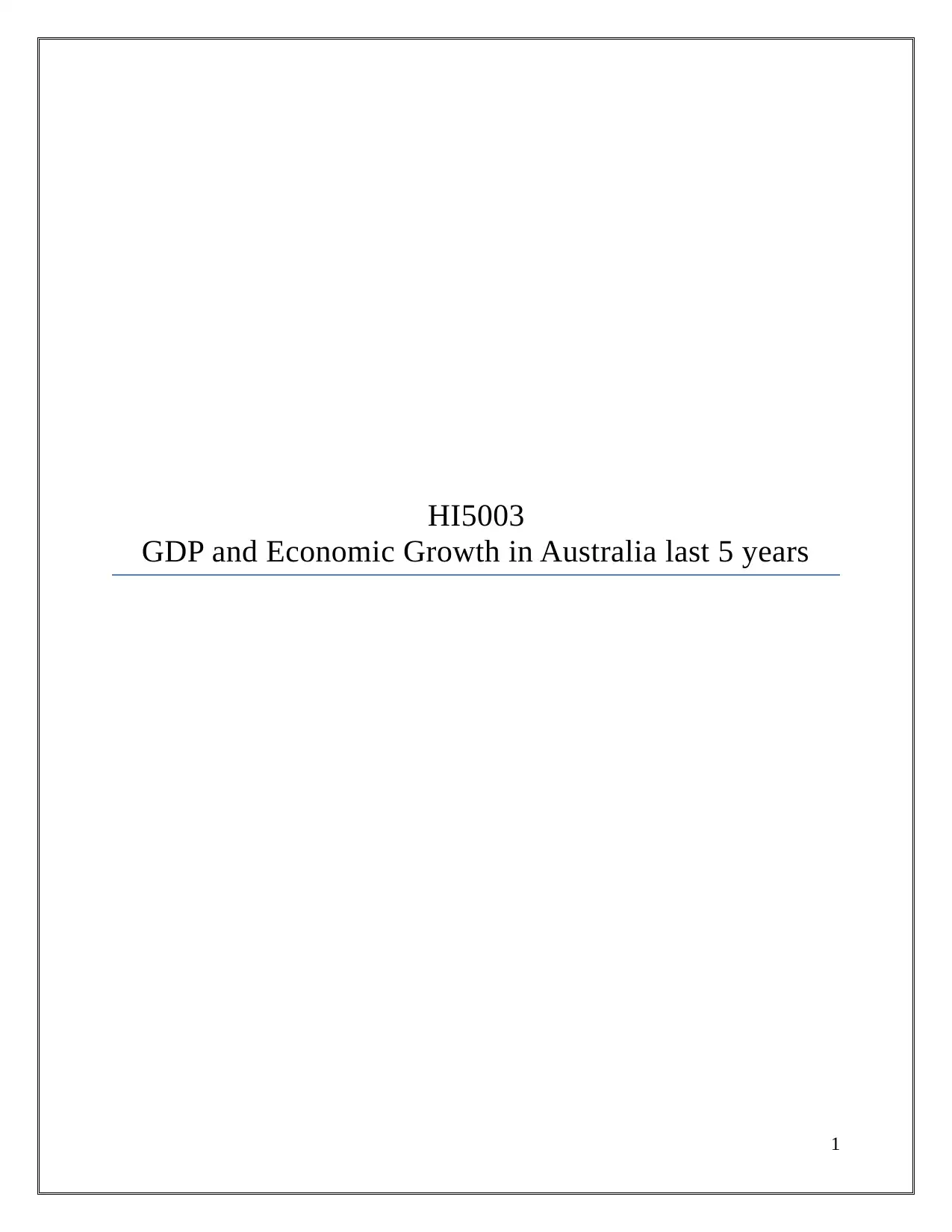
HI5003
GDP and Economic Growth in Australia last 5 years
1
GDP and Economic Growth in Australia last 5 years
1
Secure Best Marks with AI Grader
Need help grading? Try our AI Grader for instant feedback on your assignments.
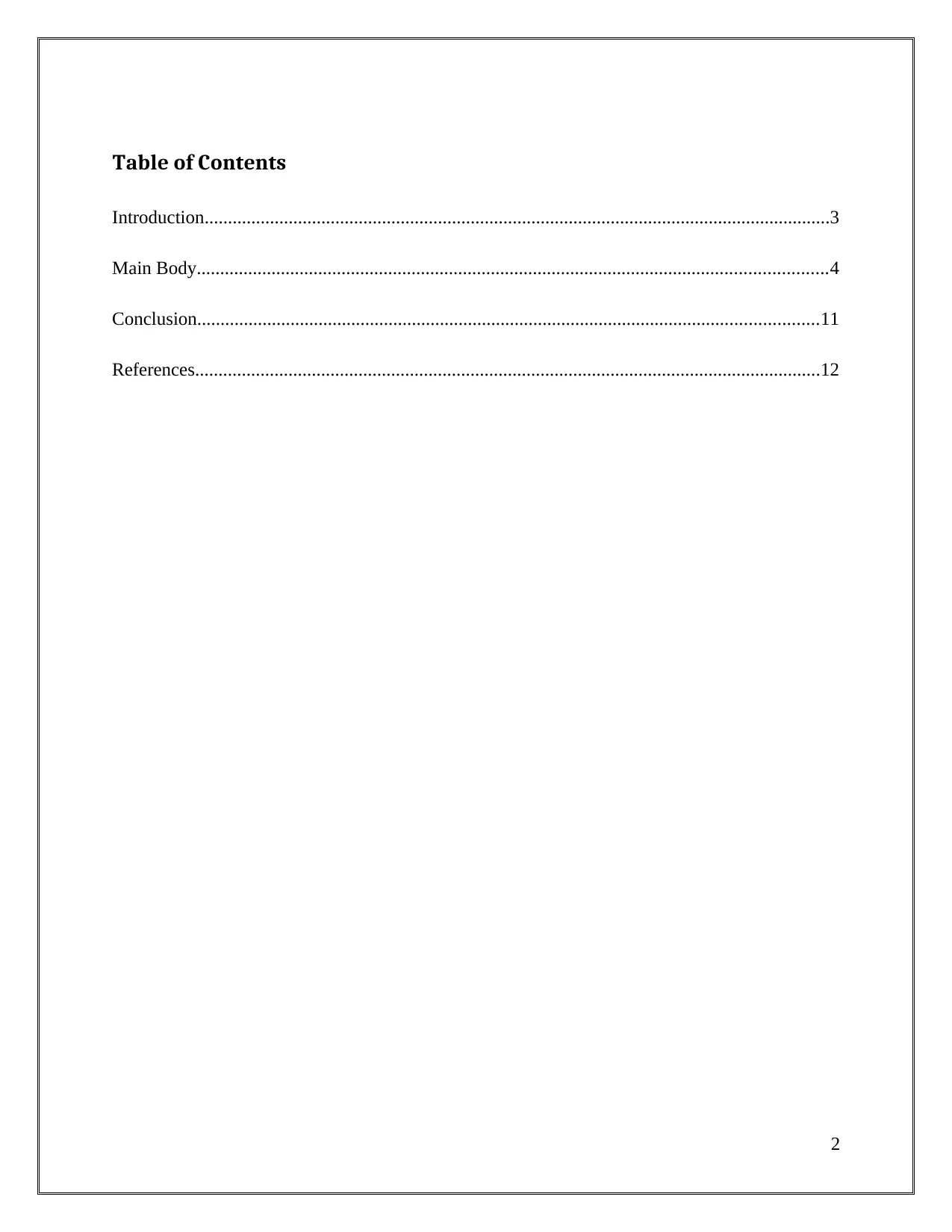
Table of Contents
Introduction......................................................................................................................................3
Main Body.......................................................................................................................................4
Conclusion.....................................................................................................................................11
References......................................................................................................................................12
2
Introduction......................................................................................................................................3
Main Body.......................................................................................................................................4
Conclusion.....................................................................................................................................11
References......................................................................................................................................12
2
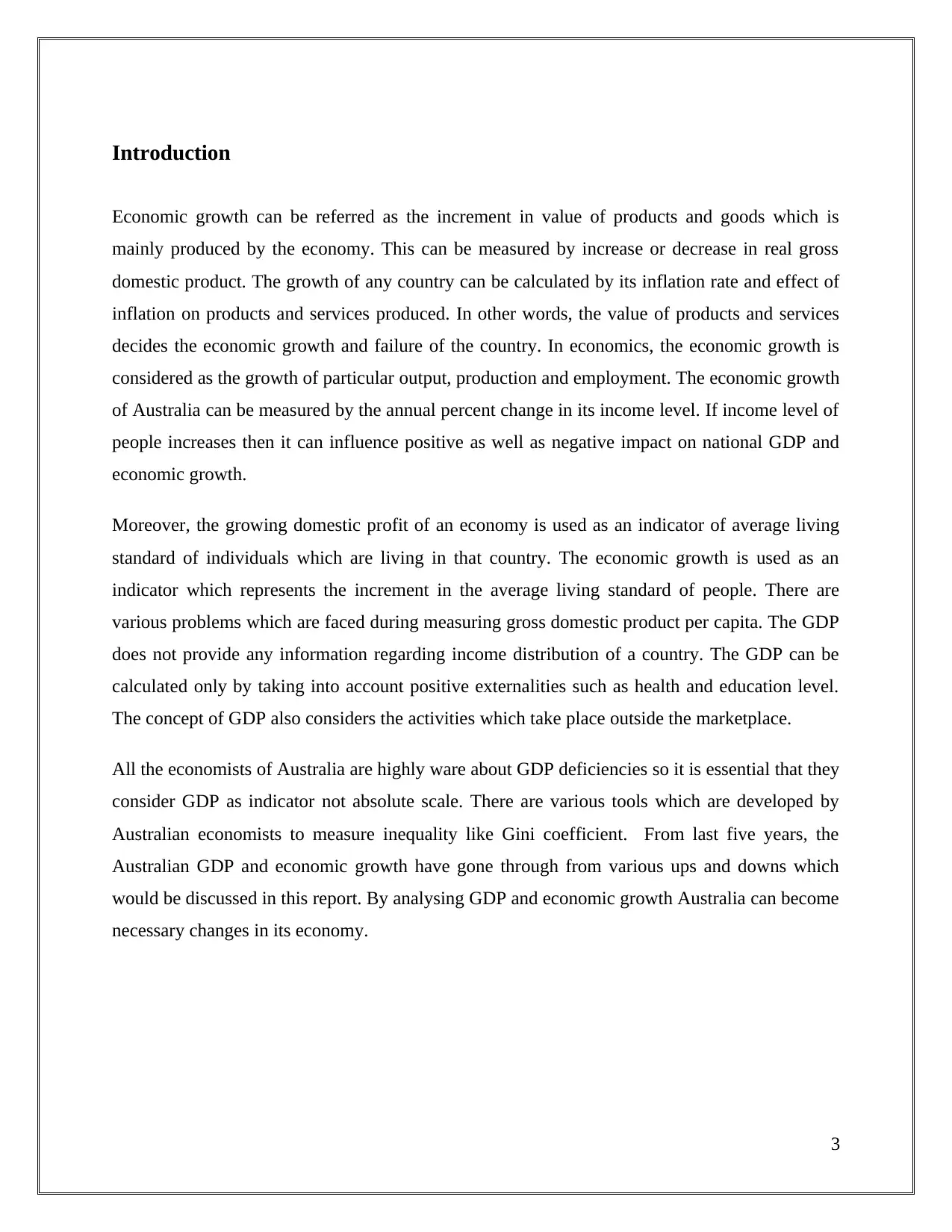
Introduction
Economic growth can be referred as the increment in value of products and goods which is
mainly produced by the economy. This can be measured by increase or decrease in real gross
domestic product. The growth of any country can be calculated by its inflation rate and effect of
inflation on products and services produced. In other words, the value of products and services
decides the economic growth and failure of the country. In economics, the economic growth is
considered as the growth of particular output, production and employment. The economic growth
of Australia can be measured by the annual percent change in its income level. If income level of
people increases then it can influence positive as well as negative impact on national GDP and
economic growth.
Moreover, the growing domestic profit of an economy is used as an indicator of average living
standard of individuals which are living in that country. The economic growth is used as an
indicator which represents the increment in the average living standard of people. There are
various problems which are faced during measuring gross domestic product per capita. The GDP
does not provide any information regarding income distribution of a country. The GDP can be
calculated only by taking into account positive externalities such as health and education level.
The concept of GDP also considers the activities which take place outside the marketplace.
All the economists of Australia are highly ware about GDP deficiencies so it is essential that they
consider GDP as indicator not absolute scale. There are various tools which are developed by
Australian economists to measure inequality like Gini coefficient. From last five years, the
Australian GDP and economic growth have gone through from various ups and downs which
would be discussed in this report. By analysing GDP and economic growth Australia can become
necessary changes in its economy.
3
Economic growth can be referred as the increment in value of products and goods which is
mainly produced by the economy. This can be measured by increase or decrease in real gross
domestic product. The growth of any country can be calculated by its inflation rate and effect of
inflation on products and services produced. In other words, the value of products and services
decides the economic growth and failure of the country. In economics, the economic growth is
considered as the growth of particular output, production and employment. The economic growth
of Australia can be measured by the annual percent change in its income level. If income level of
people increases then it can influence positive as well as negative impact on national GDP and
economic growth.
Moreover, the growing domestic profit of an economy is used as an indicator of average living
standard of individuals which are living in that country. The economic growth is used as an
indicator which represents the increment in the average living standard of people. There are
various problems which are faced during measuring gross domestic product per capita. The GDP
does not provide any information regarding income distribution of a country. The GDP can be
calculated only by taking into account positive externalities such as health and education level.
The concept of GDP also considers the activities which take place outside the marketplace.
All the economists of Australia are highly ware about GDP deficiencies so it is essential that they
consider GDP as indicator not absolute scale. There are various tools which are developed by
Australian economists to measure inequality like Gini coefficient. From last five years, the
Australian GDP and economic growth have gone through from various ups and downs which
would be discussed in this report. By analysing GDP and economic growth Australia can become
necessary changes in its economy.
3
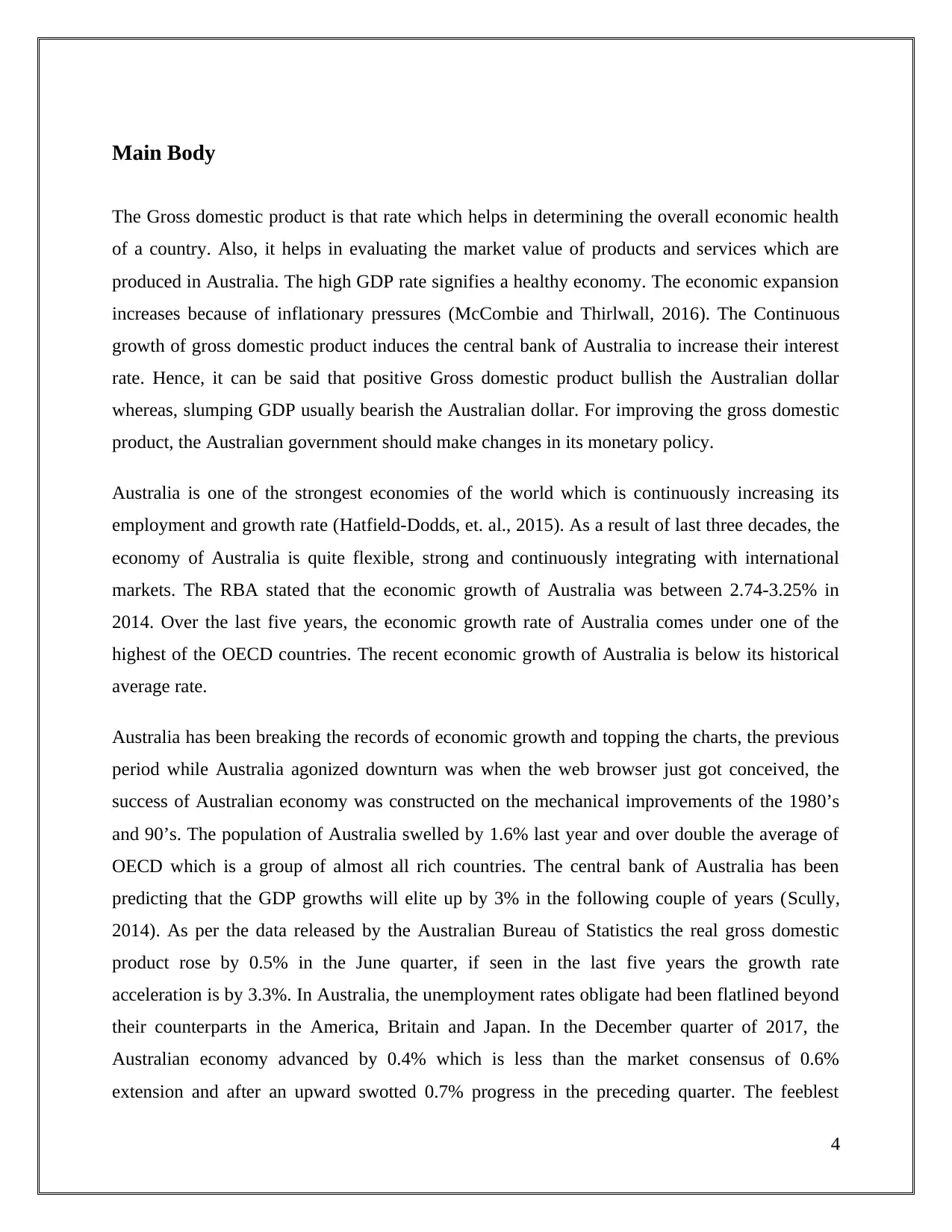
Main Body
The Gross domestic product is that rate which helps in determining the overall economic health
of a country. Also, it helps in evaluating the market value of products and services which are
produced in Australia. The high GDP rate signifies a healthy economy. The economic expansion
increases because of inflationary pressures (McCombie and Thirlwall, 2016). The Continuous
growth of gross domestic product induces the central bank of Australia to increase their interest
rate. Hence, it can be said that positive Gross domestic product bullish the Australian dollar
whereas, slumping GDP usually bearish the Australian dollar. For improving the gross domestic
product, the Australian government should make changes in its monetary policy.
Australia is one of the strongest economies of the world which is continuously increasing its
employment and growth rate (Hatfield-Dodds, et. al., 2015). As a result of last three decades, the
economy of Australia is quite flexible, strong and continuously integrating with international
markets. The RBA stated that the economic growth of Australia was between 2.74-3.25% in
2014. Over the last five years, the economic growth rate of Australia comes under one of the
highest of the OECD countries. The recent economic growth of Australia is below its historical
average rate.
Australia has been breaking the records of economic growth and topping the charts, the previous
period while Australia agonized downturn was when the web browser just got conceived, the
success of Australian economy was constructed on the mechanical improvements of the 1980’s
and 90’s. The population of Australia swelled by 1.6% last year and over double the average of
OECD which is a group of almost all rich countries. The central bank of Australia has been
predicting that the GDP growths will elite up by 3% in the following couple of years (Scully,
2014). As per the data released by the Australian Bureau of Statistics the real gross domestic
product rose by 0.5% in the June quarter, if seen in the last five years the growth rate
acceleration is by 3.3%. In Australia, the unemployment rates obligate had been flatlined beyond
their counterparts in the America, Britain and Japan. In the December quarter of 2017, the
Australian economy advanced by 0.4% which is less than the market consensus of 0.6%
extension and after an upward swotted 0.7% progress in the preceding quarter. The feeblest
4
The Gross domestic product is that rate which helps in determining the overall economic health
of a country. Also, it helps in evaluating the market value of products and services which are
produced in Australia. The high GDP rate signifies a healthy economy. The economic expansion
increases because of inflationary pressures (McCombie and Thirlwall, 2016). The Continuous
growth of gross domestic product induces the central bank of Australia to increase their interest
rate. Hence, it can be said that positive Gross domestic product bullish the Australian dollar
whereas, slumping GDP usually bearish the Australian dollar. For improving the gross domestic
product, the Australian government should make changes in its monetary policy.
Australia is one of the strongest economies of the world which is continuously increasing its
employment and growth rate (Hatfield-Dodds, et. al., 2015). As a result of last three decades, the
economy of Australia is quite flexible, strong and continuously integrating with international
markets. The RBA stated that the economic growth of Australia was between 2.74-3.25% in
2014. Over the last five years, the economic growth rate of Australia comes under one of the
highest of the OECD countries. The recent economic growth of Australia is below its historical
average rate.
Australia has been breaking the records of economic growth and topping the charts, the previous
period while Australia agonized downturn was when the web browser just got conceived, the
success of Australian economy was constructed on the mechanical improvements of the 1980’s
and 90’s. The population of Australia swelled by 1.6% last year and over double the average of
OECD which is a group of almost all rich countries. The central bank of Australia has been
predicting that the GDP growths will elite up by 3% in the following couple of years (Scully,
2014). As per the data released by the Australian Bureau of Statistics the real gross domestic
product rose by 0.5% in the June quarter, if seen in the last five years the growth rate
acceleration is by 3.3%. In Australia, the unemployment rates obligate had been flatlined beyond
their counterparts in the America, Britain and Japan. In the December quarter of 2017, the
Australian economy advanced by 0.4% which is less than the market consensus of 0.6%
extension and after an upward swotted 0.7% progress in the preceding quarter. The feeblest
4
Paraphrase This Document
Need a fresh take? Get an instant paraphrase of this document with our AI Paraphraser

development rate in the last five years of the economy was in the September quarter of 2016
(Wiersema and Leon, 2016).
(Source: Trading economies, 2018).
In the three months of the December, the positive consumptions were made by the consumption
of household (0.6%), the Government spending was at 0.3%, the public investment was of 0.2%,
the private investment in the machinery was of 0.1% and the investment in dwellings was of -
0.1%. The expenditure of final consumption rose by 1.1% for the household spending it
increased by 1%, hotels and restaurants rose by 2.9% and the Government expenditure rose by
1.7%.
The total inventories increased by 14 million AUD following the fall of 93 million AUD in the
prior quarter and the increase in inventories were built up by the mining inventories. Australia
can be said as unique among the advanced economies (Wiersema and Leon, 2016). The success
paths in the success of the Australian economy have been said the nationwide strategy
discussions about in what way to traffic onward. The structural shifts of the Australian economy
are happening universally, which are reflective of long-haul implications for discrete economies.
The global economy of Australia was reshaped by four forces named as sustainability,
demography, technology and shifting economic weight. The key emphasis of the Australian
management would be on in what way to generate the ground-breaking and entrepreneurial
business culture. By 2055 Australia is probable to have around 40,000 people who will be over
5
(Wiersema and Leon, 2016).
(Source: Trading economies, 2018).
In the three months of the December, the positive consumptions were made by the consumption
of household (0.6%), the Government spending was at 0.3%, the public investment was of 0.2%,
the private investment in the machinery was of 0.1% and the investment in dwellings was of -
0.1%. The expenditure of final consumption rose by 1.1% for the household spending it
increased by 1%, hotels and restaurants rose by 2.9% and the Government expenditure rose by
1.7%.
The total inventories increased by 14 million AUD following the fall of 93 million AUD in the
prior quarter and the increase in inventories were built up by the mining inventories. Australia
can be said as unique among the advanced economies (Wiersema and Leon, 2016). The success
paths in the success of the Australian economy have been said the nationwide strategy
discussions about in what way to traffic onward. The structural shifts of the Australian economy
are happening universally, which are reflective of long-haul implications for discrete economies.
The global economy of Australia was reshaped by four forces named as sustainability,
demography, technology and shifting economic weight. The key emphasis of the Australian
management would be on in what way to generate the ground-breaking and entrepreneurial
business culture. By 2055 Australia is probable to have around 40,000 people who will be over
5
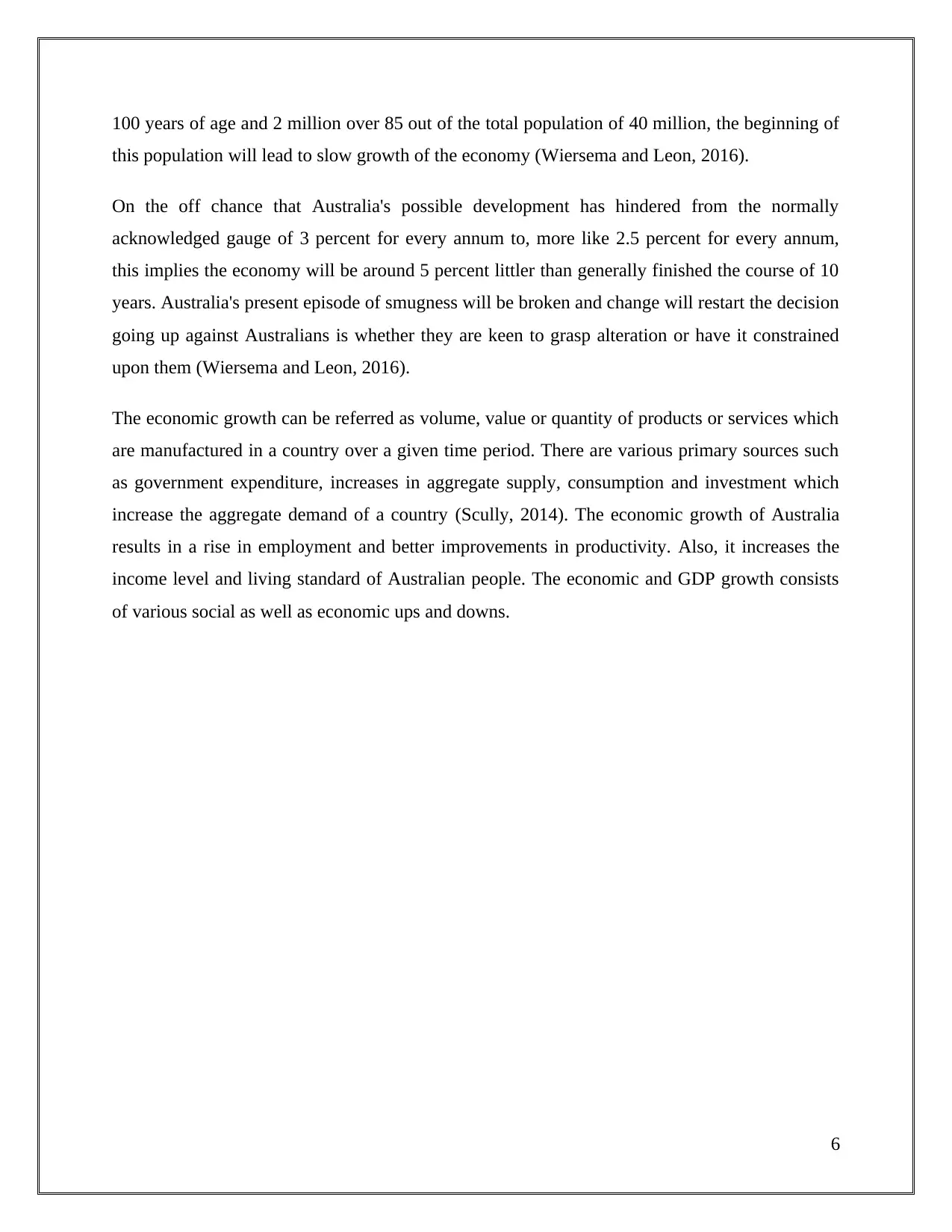
100 years of age and 2 million over 85 out of the total population of 40 million, the beginning of
this population will lead to slow growth of the economy (Wiersema and Leon, 2016).
On the off chance that Australia's possible development has hindered from the normally
acknowledged gauge of 3 percent for every annum to, more like 2.5 percent for every annum,
this implies the economy will be around 5 percent littler than generally finished the course of 10
years. Australia's present episode of smugness will be broken and change will restart the decision
going up against Australians is whether they are keen to grasp alteration or have it constrained
upon them (Wiersema and Leon, 2016).
The economic growth can be referred as volume, value or quantity of products or services which
are manufactured in a country over a given time period. There are various primary sources such
as government expenditure, increases in aggregate supply, consumption and investment which
increase the aggregate demand of a country (Scully, 2014). The economic growth of Australia
results in a rise in employment and better improvements in productivity. Also, it increases the
income level and living standard of Australian people. The economic and GDP growth consists
of various social as well as economic ups and downs.
6
this population will lead to slow growth of the economy (Wiersema and Leon, 2016).
On the off chance that Australia's possible development has hindered from the normally
acknowledged gauge of 3 percent for every annum to, more like 2.5 percent for every annum,
this implies the economy will be around 5 percent littler than generally finished the course of 10
years. Australia's present episode of smugness will be broken and change will restart the decision
going up against Australians is whether they are keen to grasp alteration or have it constrained
upon them (Wiersema and Leon, 2016).
The economic growth can be referred as volume, value or quantity of products or services which
are manufactured in a country over a given time period. There are various primary sources such
as government expenditure, increases in aggregate supply, consumption and investment which
increase the aggregate demand of a country (Scully, 2014). The economic growth of Australia
results in a rise in employment and better improvements in productivity. Also, it increases the
income level and living standard of Australian people. The economic and GDP growth consists
of various social as well as economic ups and downs.
6
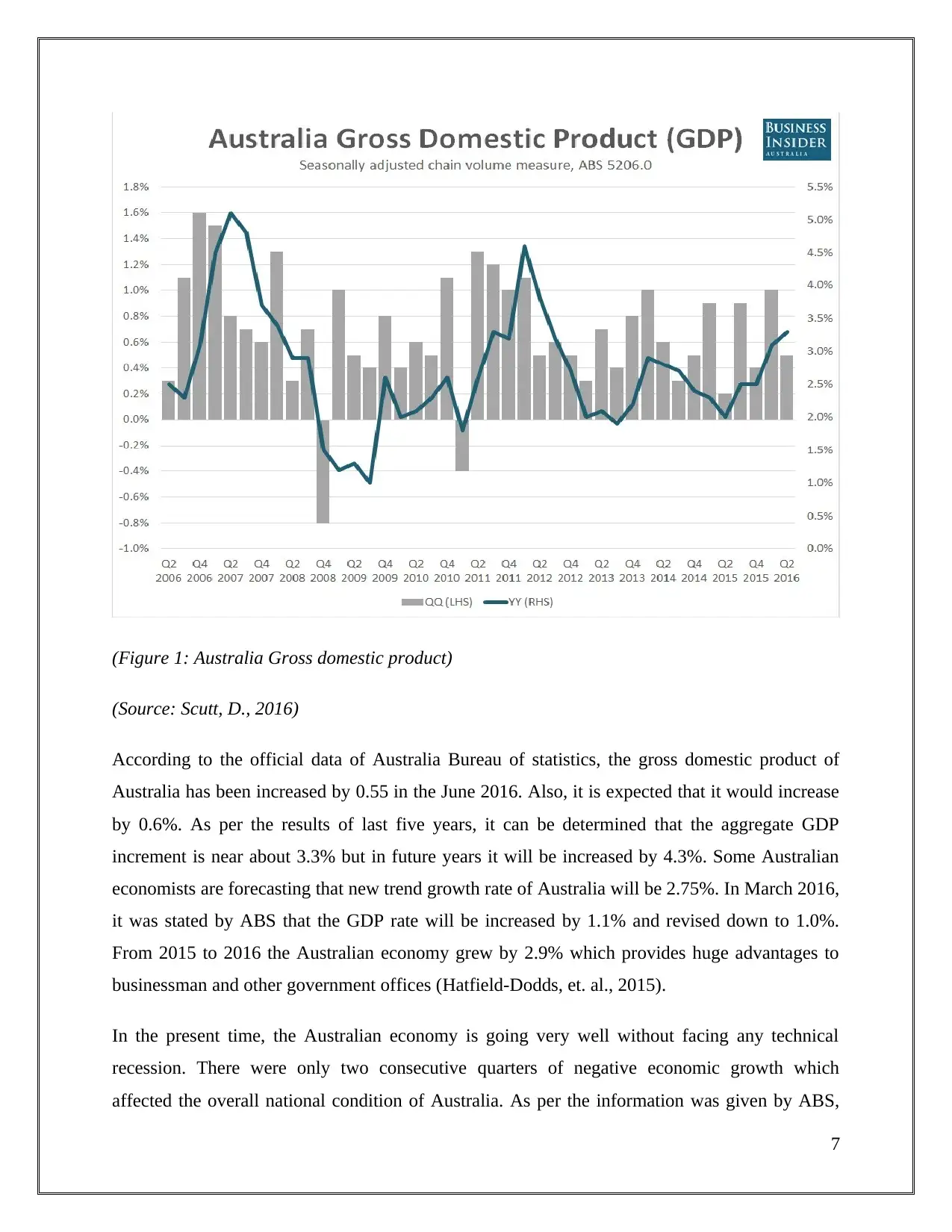
(Figure 1: Australia Gross domestic product)
(Source: Scutt, D., 2016)
According to the official data of Australia Bureau of statistics, the gross domestic product of
Australia has been increased by 0.55 in the June 2016. Also, it is expected that it would increase
by 0.6%. As per the results of last five years, it can be determined that the aggregate GDP
increment is near about 3.3% but in future years it will be increased by 4.3%. Some Australian
economists are forecasting that new trend growth rate of Australia will be 2.75%. In March 2016,
it was stated by ABS that the GDP rate will be increased by 1.1% and revised down to 1.0%.
From 2015 to 2016 the Australian economy grew by 2.9% which provides huge advantages to
businessman and other government offices (Hatfield-Dodds, et. al., 2015).
In the present time, the Australian economy is going very well without facing any technical
recession. There were only two consecutive quarters of negative economic growth which
affected the overall national condition of Australia. As per the information was given by ABS,
7
(Source: Scutt, D., 2016)
According to the official data of Australia Bureau of statistics, the gross domestic product of
Australia has been increased by 0.55 in the June 2016. Also, it is expected that it would increase
by 0.6%. As per the results of last five years, it can be determined that the aggregate GDP
increment is near about 3.3% but in future years it will be increased by 4.3%. Some Australian
economists are forecasting that new trend growth rate of Australia will be 2.75%. In March 2016,
it was stated by ABS that the GDP rate will be increased by 1.1% and revised down to 1.0%.
From 2015 to 2016 the Australian economy grew by 2.9% which provides huge advantages to
businessman and other government offices (Hatfield-Dodds, et. al., 2015).
In the present time, the Australian economy is going very well without facing any technical
recession. There were only two consecutive quarters of negative economic growth which
affected the overall national condition of Australia. As per the information was given by ABS,
7
Secure Best Marks with AI Grader
Need help grading? Try our AI Grader for instant feedback on your assignments.

the growth of its June 2016 was driven by its domestic final demand which increased by 0.6%.
Also, it was supported by continuous growth in public and household consumption. The
continuous reduction in engineering construction was driven by offset growth in public
investment. In 2013, the international trade of Australia was detracted because of growth in
imports and slowdown in export growth (McCombie and Thirlwall, 2016).
The continuous growth in imports was the major component which contributed to the GDP
growth of Australia. In GDP growth all individuals contributed equally which resulted in the
high economic growth of the country. In 2014, the government consumption was increased by
1.9% which added 0.3% in GDP growth. In the same year, the public investment was increased
by 15.5% which was driven by local as well as state government. The transfer of assets from
public to private sector contributed near around 3.4% in the private investment. The overall
contribution of government in GDP was 0.7%.
(Figure 2: Real GDP Growth 2012-2017)
(Source: Mitchell, 2011)
8
Also, it was supported by continuous growth in public and household consumption. The
continuous reduction in engineering construction was driven by offset growth in public
investment. In 2013, the international trade of Australia was detracted because of growth in
imports and slowdown in export growth (McCombie and Thirlwall, 2016).
The continuous growth in imports was the major component which contributed to the GDP
growth of Australia. In GDP growth all individuals contributed equally which resulted in the
high economic growth of the country. In 2014, the government consumption was increased by
1.9% which added 0.3% in GDP growth. In the same year, the public investment was increased
by 15.5% which was driven by local as well as state government. The transfer of assets from
public to private sector contributed near around 3.4% in the private investment. The overall
contribution of government in GDP was 0.7%.
(Figure 2: Real GDP Growth 2012-2017)
(Source: Mitchell, 2011)
8
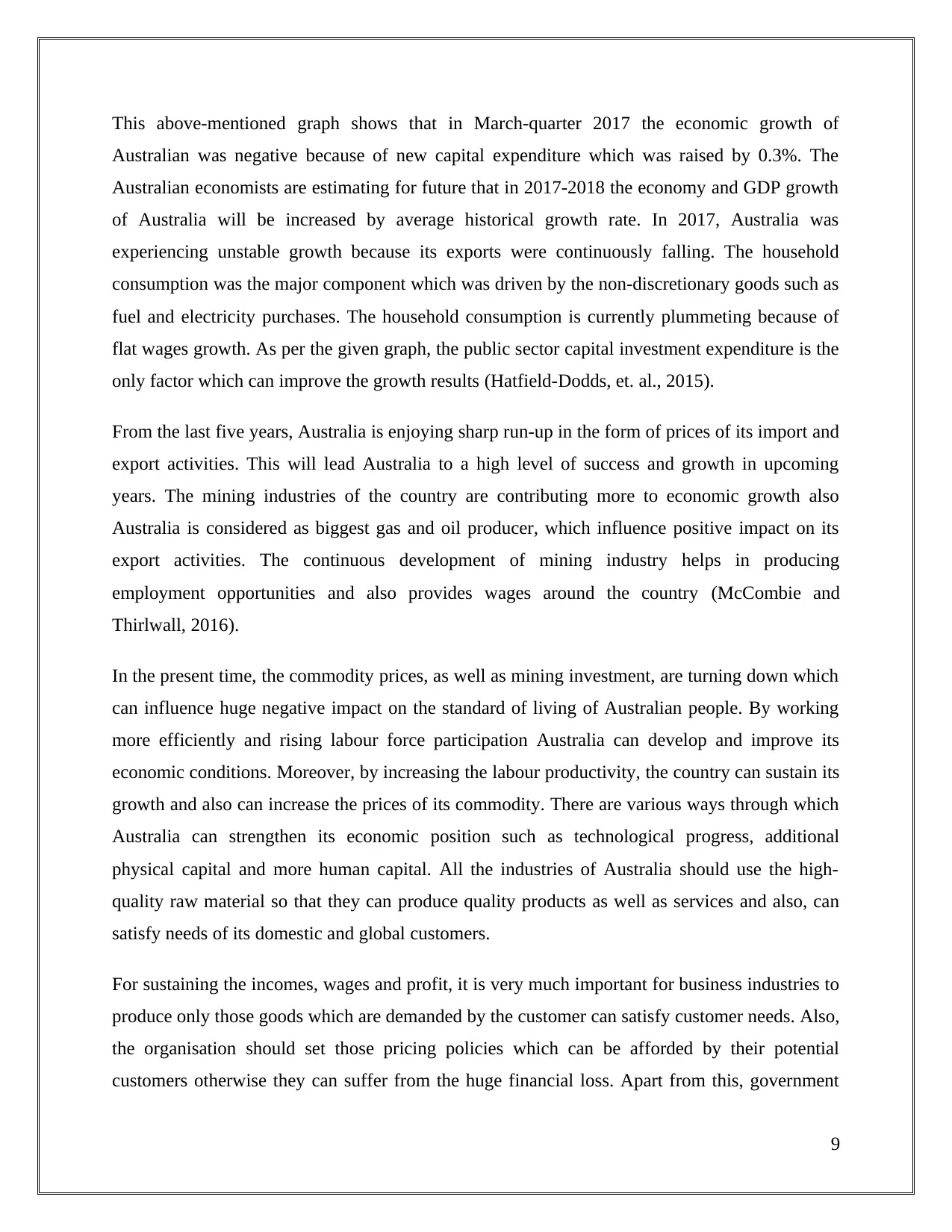
This above-mentioned graph shows that in March-quarter 2017 the economic growth of
Australian was negative because of new capital expenditure which was raised by 0.3%. The
Australian economists are estimating for future that in 2017-2018 the economy and GDP growth
of Australia will be increased by average historical growth rate. In 2017, Australia was
experiencing unstable growth because its exports were continuously falling. The household
consumption was the major component which was driven by the non-discretionary goods such as
fuel and electricity purchases. The household consumption is currently plummeting because of
flat wages growth. As per the given graph, the public sector capital investment expenditure is the
only factor which can improve the growth results (Hatfield-Dodds, et. al., 2015).
From the last five years, Australia is enjoying sharp run-up in the form of prices of its import and
export activities. This will lead Australia to a high level of success and growth in upcoming
years. The mining industries of the country are contributing more to economic growth also
Australia is considered as biggest gas and oil producer, which influence positive impact on its
export activities. The continuous development of mining industry helps in producing
employment opportunities and also provides wages around the country (McCombie and
Thirlwall, 2016).
In the present time, the commodity prices, as well as mining investment, are turning down which
can influence huge negative impact on the standard of living of Australian people. By working
more efficiently and rising labour force participation Australia can develop and improve its
economic conditions. Moreover, by increasing the labour productivity, the country can sustain its
growth and also can increase the prices of its commodity. There are various ways through which
Australia can strengthen its economic position such as technological progress, additional
physical capital and more human capital. All the industries of Australia should use the high-
quality raw material so that they can produce quality products as well as services and also, can
satisfy needs of its domestic and global customers.
For sustaining the incomes, wages and profit, it is very much important for business industries to
produce only those goods which are demanded by the customer can satisfy customer needs. Also,
the organisation should set those pricing policies which can be afforded by their potential
customers otherwise they can suffer from the huge financial loss. Apart from this, government
9
Australian was negative because of new capital expenditure which was raised by 0.3%. The
Australian economists are estimating for future that in 2017-2018 the economy and GDP growth
of Australia will be increased by average historical growth rate. In 2017, Australia was
experiencing unstable growth because its exports were continuously falling. The household
consumption was the major component which was driven by the non-discretionary goods such as
fuel and electricity purchases. The household consumption is currently plummeting because of
flat wages growth. As per the given graph, the public sector capital investment expenditure is the
only factor which can improve the growth results (Hatfield-Dodds, et. al., 2015).
From the last five years, Australia is enjoying sharp run-up in the form of prices of its import and
export activities. This will lead Australia to a high level of success and growth in upcoming
years. The mining industries of the country are contributing more to economic growth also
Australia is considered as biggest gas and oil producer, which influence positive impact on its
export activities. The continuous development of mining industry helps in producing
employment opportunities and also provides wages around the country (McCombie and
Thirlwall, 2016).
In the present time, the commodity prices, as well as mining investment, are turning down which
can influence huge negative impact on the standard of living of Australian people. By working
more efficiently and rising labour force participation Australia can develop and improve its
economic conditions. Moreover, by increasing the labour productivity, the country can sustain its
growth and also can increase the prices of its commodity. There are various ways through which
Australia can strengthen its economic position such as technological progress, additional
physical capital and more human capital. All the industries of Australia should use the high-
quality raw material so that they can produce quality products as well as services and also, can
satisfy needs of its domestic and global customers.
For sustaining the incomes, wages and profit, it is very much important for business industries to
produce only those goods which are demanded by the customer can satisfy customer needs. Also,
the organisation should set those pricing policies which can be afforded by their potential
customers otherwise they can suffer from the huge financial loss. Apart from this, government
9
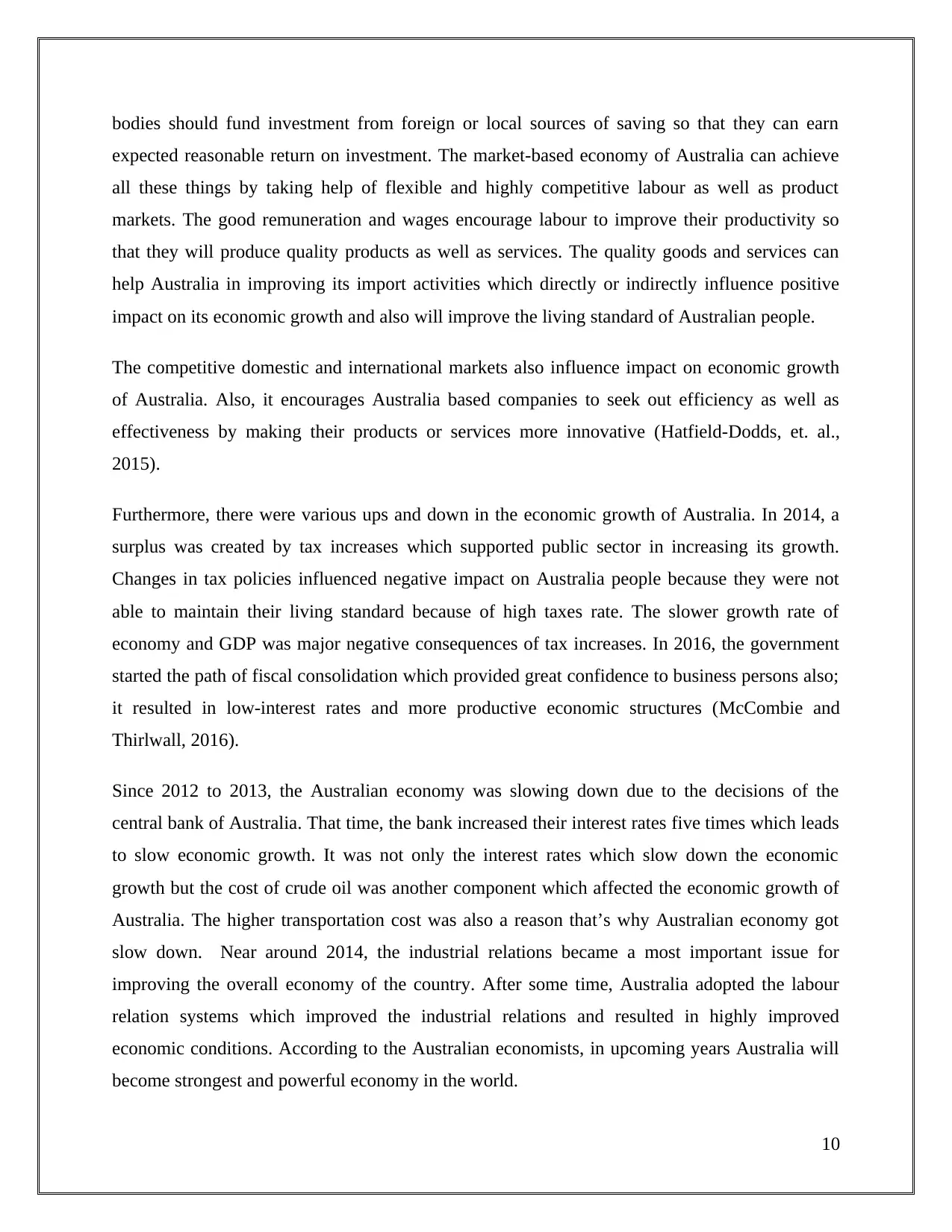
bodies should fund investment from foreign or local sources of saving so that they can earn
expected reasonable return on investment. The market-based economy of Australia can achieve
all these things by taking help of flexible and highly competitive labour as well as product
markets. The good remuneration and wages encourage labour to improve their productivity so
that they will produce quality products as well as services. The quality goods and services can
help Australia in improving its import activities which directly or indirectly influence positive
impact on its economic growth and also will improve the living standard of Australian people.
The competitive domestic and international markets also influence impact on economic growth
of Australia. Also, it encourages Australia based companies to seek out efficiency as well as
effectiveness by making their products or services more innovative (Hatfield-Dodds, et. al.,
2015).
Furthermore, there were various ups and down in the economic growth of Australia. In 2014, a
surplus was created by tax increases which supported public sector in increasing its growth.
Changes in tax policies influenced negative impact on Australia people because they were not
able to maintain their living standard because of high taxes rate. The slower growth rate of
economy and GDP was major negative consequences of tax increases. In 2016, the government
started the path of fiscal consolidation which provided great confidence to business persons also;
it resulted in low-interest rates and more productive economic structures (McCombie and
Thirlwall, 2016).
Since 2012 to 2013, the Australian economy was slowing down due to the decisions of the
central bank of Australia. That time, the bank increased their interest rates five times which leads
to slow economic growth. It was not only the interest rates which slow down the economic
growth but the cost of crude oil was another component which affected the economic growth of
Australia. The higher transportation cost was also a reason that’s why Australian economy got
slow down. Near around 2014, the industrial relations became a most important issue for
improving the overall economy of the country. After some time, Australia adopted the labour
relation systems which improved the industrial relations and resulted in highly improved
economic conditions. According to the Australian economists, in upcoming years Australia will
become strongest and powerful economy in the world.
10
expected reasonable return on investment. The market-based economy of Australia can achieve
all these things by taking help of flexible and highly competitive labour as well as product
markets. The good remuneration and wages encourage labour to improve their productivity so
that they will produce quality products as well as services. The quality goods and services can
help Australia in improving its import activities which directly or indirectly influence positive
impact on its economic growth and also will improve the living standard of Australian people.
The competitive domestic and international markets also influence impact on economic growth
of Australia. Also, it encourages Australia based companies to seek out efficiency as well as
effectiveness by making their products or services more innovative (Hatfield-Dodds, et. al.,
2015).
Furthermore, there were various ups and down in the economic growth of Australia. In 2014, a
surplus was created by tax increases which supported public sector in increasing its growth.
Changes in tax policies influenced negative impact on Australia people because they were not
able to maintain their living standard because of high taxes rate. The slower growth rate of
economy and GDP was major negative consequences of tax increases. In 2016, the government
started the path of fiscal consolidation which provided great confidence to business persons also;
it resulted in low-interest rates and more productive economic structures (McCombie and
Thirlwall, 2016).
Since 2012 to 2013, the Australian economy was slowing down due to the decisions of the
central bank of Australia. That time, the bank increased their interest rates five times which leads
to slow economic growth. It was not only the interest rates which slow down the economic
growth but the cost of crude oil was another component which affected the economic growth of
Australia. The higher transportation cost was also a reason that’s why Australian economy got
slow down. Near around 2014, the industrial relations became a most important issue for
improving the overall economy of the country. After some time, Australia adopted the labour
relation systems which improved the industrial relations and resulted in highly improved
economic conditions. According to the Australian economists, in upcoming years Australia will
become strongest and powerful economy in the world.
10
Paraphrase This Document
Need a fresh take? Get an instant paraphrase of this document with our AI Paraphraser
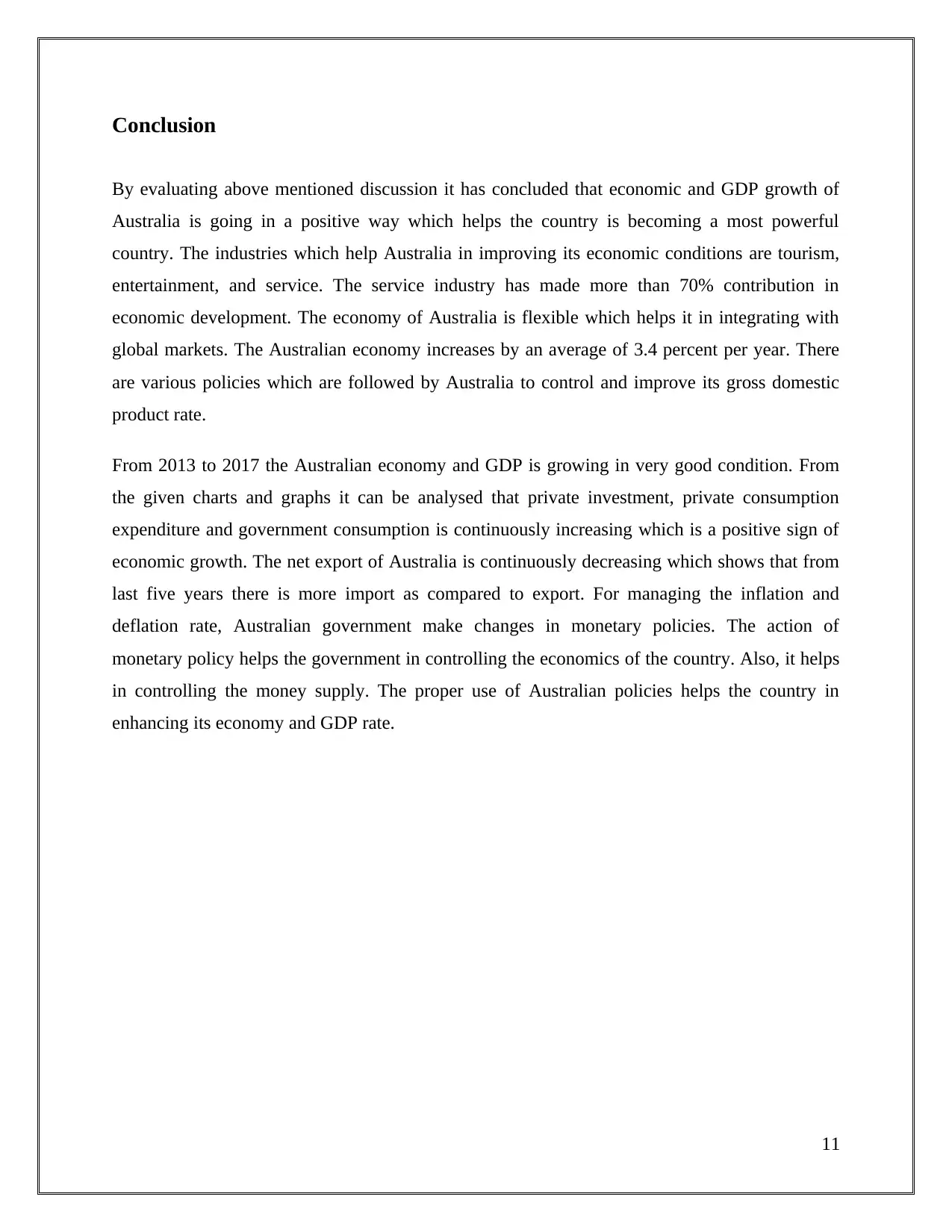
Conclusion
By evaluating above mentioned discussion it has concluded that economic and GDP growth of
Australia is going in a positive way which helps the country is becoming a most powerful
country. The industries which help Australia in improving its economic conditions are tourism,
entertainment, and service. The service industry has made more than 70% contribution in
economic development. The economy of Australia is flexible which helps it in integrating with
global markets. The Australian economy increases by an average of 3.4 percent per year. There
are various policies which are followed by Australia to control and improve its gross domestic
product rate.
From 2013 to 2017 the Australian economy and GDP is growing in very good condition. From
the given charts and graphs it can be analysed that private investment, private consumption
expenditure and government consumption is continuously increasing which is a positive sign of
economic growth. The net export of Australia is continuously decreasing which shows that from
last five years there is more import as compared to export. For managing the inflation and
deflation rate, Australian government make changes in monetary policies. The action of
monetary policy helps the government in controlling the economics of the country. Also, it helps
in controlling the money supply. The proper use of Australian policies helps the country in
enhancing its economy and GDP rate.
11
By evaluating above mentioned discussion it has concluded that economic and GDP growth of
Australia is going in a positive way which helps the country is becoming a most powerful
country. The industries which help Australia in improving its economic conditions are tourism,
entertainment, and service. The service industry has made more than 70% contribution in
economic development. The economy of Australia is flexible which helps it in integrating with
global markets. The Australian economy increases by an average of 3.4 percent per year. There
are various policies which are followed by Australia to control and improve its gross domestic
product rate.
From 2013 to 2017 the Australian economy and GDP is growing in very good condition. From
the given charts and graphs it can be analysed that private investment, private consumption
expenditure and government consumption is continuously increasing which is a positive sign of
economic growth. The net export of Australia is continuously decreasing which shows that from
last five years there is more import as compared to export. For managing the inflation and
deflation rate, Australian government make changes in monetary policies. The action of
monetary policy helps the government in controlling the economics of the country. Also, it helps
in controlling the money supply. The proper use of Australian policies helps the country in
enhancing its economy and GDP rate.
11
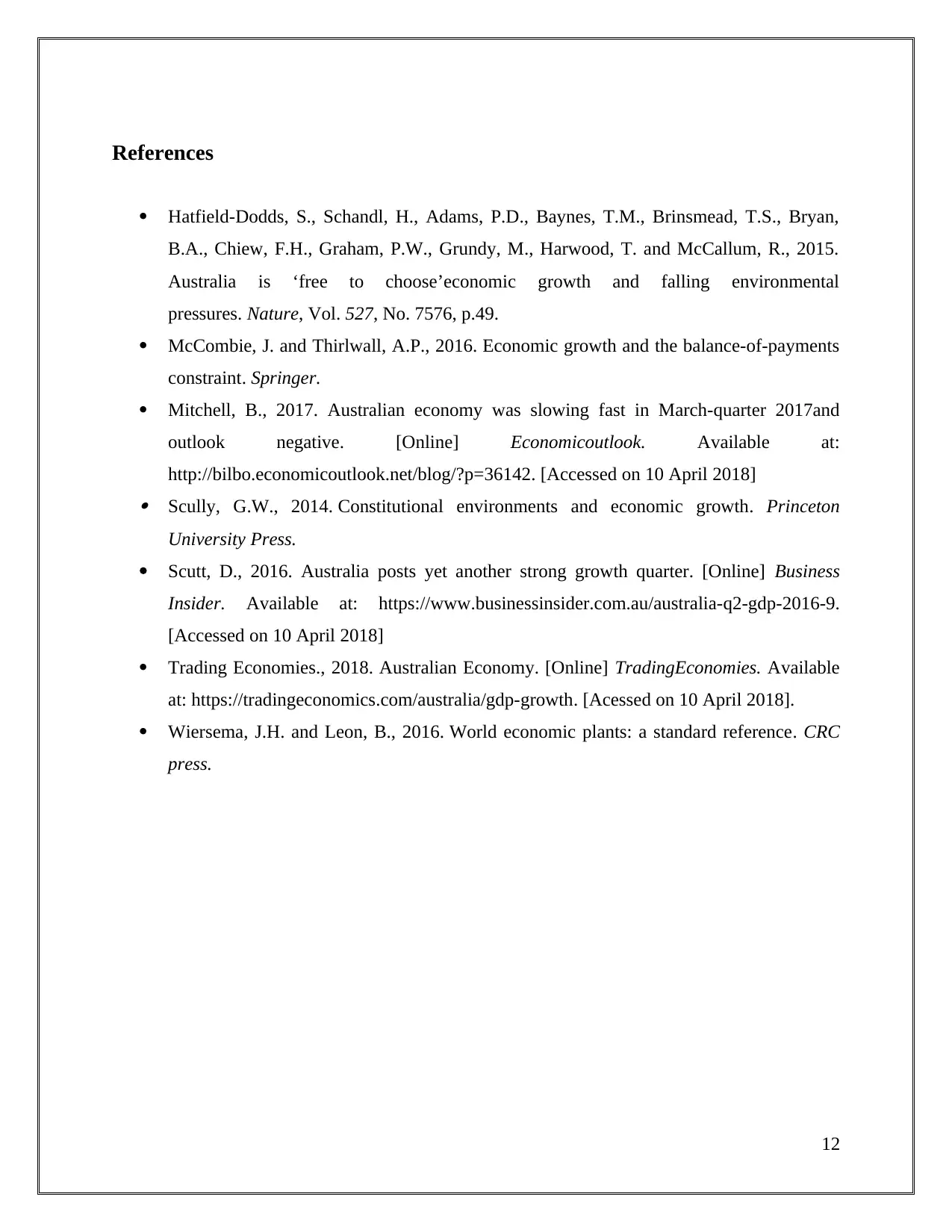
References
Hatfield-Dodds, S., Schandl, H., Adams, P.D., Baynes, T.M., Brinsmead, T.S., Bryan,
B.A., Chiew, F.H., Graham, P.W., Grundy, M., Harwood, T. and McCallum, R., 2015.
Australia is ‘free to choose’economic growth and falling environmental
pressures. Nature, Vol. 527, No. 7576, p.49.
McCombie, J. and Thirlwall, A.P., 2016. Economic growth and the balance-of-payments
constraint. Springer.
Mitchell, B., 2017. Australian economy was slowing fast in March-quarter 2017and
outlook negative. [Online] Economicoutlook. Available at:
http://bilbo.economicoutlook.net/blog/?p=36142. [Accessed on 10 April 2018] Scully, G.W., 2014. Constitutional environments and economic growth. Princeton
University Press.
Scutt, D., 2016. Australia posts yet another strong growth quarter. [Online] Business
Insider. Available at: https://www.businessinsider.com.au/australia-q2-gdp-2016-9.
[Accessed on 10 April 2018]
Trading Economies., 2018. Australian Economy. [Online] TradingEconomies. Available
at: https://tradingeconomics.com/australia/gdp-growth. [Acessed on 10 April 2018].
Wiersema, J.H. and Leon, B., 2016. World economic plants: a standard reference. CRC
press.
12
Hatfield-Dodds, S., Schandl, H., Adams, P.D., Baynes, T.M., Brinsmead, T.S., Bryan,
B.A., Chiew, F.H., Graham, P.W., Grundy, M., Harwood, T. and McCallum, R., 2015.
Australia is ‘free to choose’economic growth and falling environmental
pressures. Nature, Vol. 527, No. 7576, p.49.
McCombie, J. and Thirlwall, A.P., 2016. Economic growth and the balance-of-payments
constraint. Springer.
Mitchell, B., 2017. Australian economy was slowing fast in March-quarter 2017and
outlook negative. [Online] Economicoutlook. Available at:
http://bilbo.economicoutlook.net/blog/?p=36142. [Accessed on 10 April 2018] Scully, G.W., 2014. Constitutional environments and economic growth. Princeton
University Press.
Scutt, D., 2016. Australia posts yet another strong growth quarter. [Online] Business
Insider. Available at: https://www.businessinsider.com.au/australia-q2-gdp-2016-9.
[Accessed on 10 April 2018]
Trading Economies., 2018. Australian Economy. [Online] TradingEconomies. Available
at: https://tradingeconomics.com/australia/gdp-growth. [Acessed on 10 April 2018].
Wiersema, J.H. and Leon, B., 2016. World economic plants: a standard reference. CRC
press.
12
1 out of 12
Related Documents
Your All-in-One AI-Powered Toolkit for Academic Success.
+13062052269
info@desklib.com
Available 24*7 on WhatsApp / Email
![[object Object]](/_next/static/media/star-bottom.7253800d.svg)
Unlock your academic potential
© 2024 | Zucol Services PVT LTD | All rights reserved.



